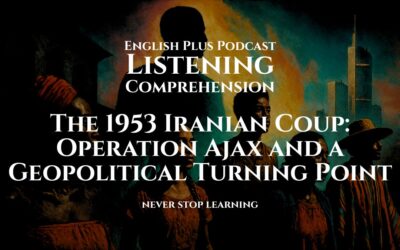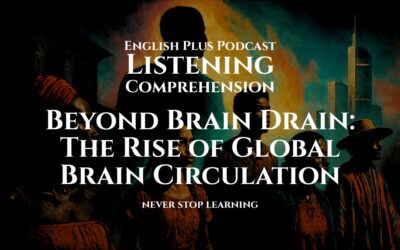Level Up Your Listening: A Deep Dive into Corporate Social Responsibility
Hello and welcome! In many English proficiency exams, you’ll encounter listening passages from the world of business and academia. These often discuss complex concepts that have evolved over time. A great strategy for these topics is to listen for contrasting ideas or different points of view. Is the speaker comparing an old way of thinking to a new one? Are they presenting arguments for and against a certain practice?
Here are a few tips tailored for business and academic listening:
- Listen for Definitions: When a speaker introduces a key term, like “Corporate Social Responsibility,” they will often follow it with a definition or explanation. Pay close attention to this.
- Identify Different Perspectives: Lectures on topics like this often contrast different theories. Listen for phrases like “In the past, the view was…” versus “However, today we see…” This shows a shift in thinking.
- Recognize Examples: Speakers use examples to make abstract ideas concrete. When you hear “For instance,” or “A case in point is…,” you know an important illustration is coming that will help you understand the main concept.
Today’s listening is a lecture from a business school course. The topic is Corporate Social Responsibility, or CSR. Let’s see how the concept has changed over the years.
Listen
Listening Quiz
Listening Transcript: Please do not read the transcript before you listen and take the quiz
Good morning, class. Let’s dive into a topic that has fundamentally reshaped the landscape of modern business: Corporate Social Responsibility, often abbreviated as CSR. For many years, the prevailing business philosophy was articulated most famously by the economist Milton Friedman back in 1970. He argued that the one and only social responsibility of a business is to use its resources and engage in activities designed to increase its profits. This is the shareholder theory in its purest form: a company’s primary duty is to its owners, the shareholders, and that duty is to maximize their financial return. For decades, this was the dominant paradigm.
However, beginning in the late 20th century and accelerating into the 21st, a different view began to take hold: the stakeholder theory. This perspective argues that a corporation has a responsibility not just to its shareholders, but to a wider group of “stakeholders.” Who are stakeholders? They include employees, customers, suppliers, the community in which the business operates, and even society as a whole. Proponents of this view contend that for a business to be successful in the long term, it must create value for all of its stakeholders, not just extract value for its owners.
This shift gave rise to the modern concept of CSR. It’s no longer seen as mere philanthropy—like a company simply writing a check to a charity at the end of the year. Instead, CSR is about integrating social and environmental concerns directly into a company’s business model and operations. It’s about how a company makes its money, not just what it does with its profits.
A popular framework for understanding this integrated approach is the “triple bottom line,” sometimes called the “Three P’s”: People, Planet, and Profit. A company pursuing a triple bottom line aims to measure its success not only by its financial performance (Profit) but also by its social (People) and environmental (Planet) impact. This means asking critical questions. Are we paying our employees a living wage and ensuring safe working conditions? That relates to ‘People.’ What is our carbon footprint? Are our products sustainable? That’s about the ‘Planet.’
Of course, this raises the challenge of authenticity. How can consumers and investors know if a company is genuinely committed to these principles or if it’s engaging in “greenwashing”? Greenwashing is a critical term you must know. It refers to the practice of making misleading or unsubstantiated claims about the environmental benefits of a product, service, or company policy. A company might spend millions on an advertising campaign to tell everyone how green it is, while its actual operations remain environmentally harmful. It’s a form of corporate propaganda, and discerning consumers are becoming increasingly wary of it.
So what does genuine CSR look like in practice? Let’s consider the apparel industry. A company practicing strong CSR would go beyond simply stating it cares about the environment. It would invest in ethical sourcing for its materials, like using organic cotton that requires less water. It would ensure supply chain transparency, meaning it knows exactly which factories are making its clothes and can verify that those factories provide safe conditions and fair wages to their workers. This is a stark contrast to the “fast fashion” model, which has often been criticized for exploitative labor practices and immense environmental waste.
The impetus for this shift towards more robust CSR comes from several sources. Firstly, consumer demand. Modern consumers, particularly younger generations, are increasingly making purchasing decisions based on a company’s ethical record. They are willing to pay more for products from brands they believe are doing good in the world. Secondly, there’s employee engagement. People want to work for companies that have a positive mission and reflect their own values. A strong CSR profile helps attract and retain top talent. Finally, there’s risk management. Companies with poor environmental or labor records are at greater risk of regulatory fines, consumer boycotts, and damage to their brand equity, which can be financially devastating.
In conclusion, the conversation around corporate social responsibility has matured significantly. It has moved from the periphery of business concerns to its very core. The old shareholder-centric view is no longer sufficient for long-term viability in a world where stakeholders—from customers to employees—demand more. True CSR is not a marketing gimmick; it is a fundamental component of a sustainable, resilient, and, ultimately, more profitable modern business strategy.
Advanced Vocabulary and Phrases
- Prevailing: An adjective that means existing at a particular time; current or dominant.
- How we used it: The prevailing business philosophy was the one that was most widely accepted and dominant for a long period.
- Shareholder: A noun for an owner of shares in a company.
- How we used it: Shareholder theory argues that a company’s main duty is to the shareholders, the people who own the company and want to see a financial return.
- Stakeholder: A noun for a person or group with an interest or concern in something, especially a business. This is a broader term than shareholder.
- How we used it: Stakeholder theory says a company is responsible to employees, customers, and the community—all of whom are considered stakeholders.
- Philanthropy: This noun refers to the desire to promote the welfare of others, expressed especially by the generous donation of money to good causes.
- How we used it: The lecture distinguished modern CSR from mere philanthropy, explaining that CSR is integrated into the business, not just about donating money.
- Greenwashing: A noun for the practice of making a company or product appear more environmentally friendly than it actually is.
- How we used it: We defined greenwashing as a form of corporate propaganda where a company might advertise its “green” credentials while still having harmful operations.
- Ethical sourcing: A noun phrase meaning the process of ensuring that the products being sourced are obtained in a responsible and sustainable way.
- How we used it: A company practicing ethical sourcing would, for example, choose organic cotton to minimize its environmental impact.
- Supply chain transparency: A noun phrase that means the company knows and discloses where its products and materials come from, and under what conditions they were made.
- How we used it: Supply chain transparency was given as an example of good CSR, where a company can verify that its factory workers are treated fairly.
- Brand equity: A noun phrase that refers to the commercial value that derives from consumer perception of the brand name of a particular product or service, rather than from the product or service itself.
- How we used it: A scandal can cause damage to a company’s brand equity, meaning people’s trust in and positive perception of the brand is lost, which hurts the business.
- Periphery: A noun for the outer limits or edge of an area or object. In a conceptual sense, it means a secondary or minor position.
- How we used it: The lecturer concluded that CSR has moved from the periphery of business concerns, meaning it’s no longer a minor issue, but is now central.
- Viability: A noun that means the ability to work successfully or survive.
- How we used it: The old business model is “no longer sufficient for long-term viability,” meaning it is not a successful strategy for survival in the modern world.









0 Comments